*This is an English translation of the original catalog entry in Persian
16Two mihrabs of the tomb of Emam Reza in the Shrine of Emam Reza (AS) at Mashhad
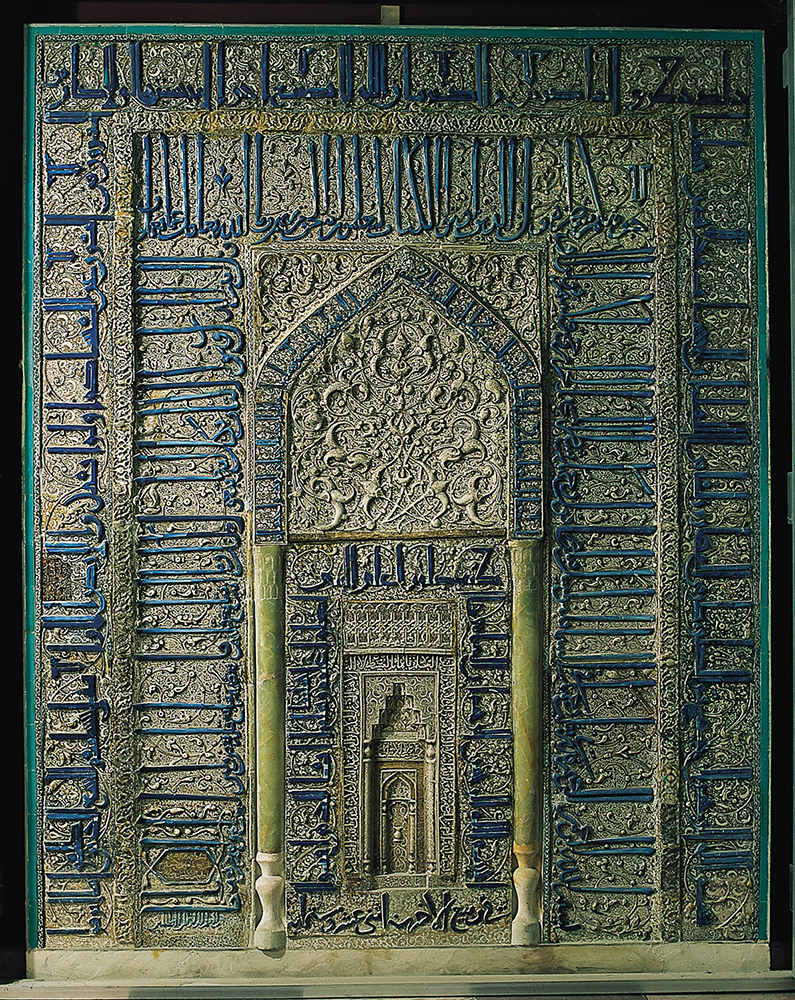
A. The mihrab before the face of Hazrat-e Reza (pish-e ru) Iran, Kharazmshahi period, Rabiʿ al-Thani 612/August 1215 Signed by Mohammad b. Abi Taher Kashani and Abu Zayd Naqqash Luster tilework [stonepaste, molded, painted] H. 8.9 × W. 7.2 ft. (H. 273 × W. 220 cm) Astan-e Qods-e Razavi Museum, Mashhad, no. 19033 Photograph ©︎ Organization of Libraries, Museums and Documents Center of Astan-e Qods-e Razavi

B. The mihrab beneath the foot of Hazrat-e Reza (pa’in-e pa) Iran, Kharazmshahi period, 13th century Luster tilework [stonepaste, molded, painted] H. 7.4 × W. 5.9 ft. (H. 228 × W. 180 cm) Astan-e Qods-e Razavi Museum, Mashhad, no. 19029 Photograph ©︎ Organization of Libraries, Museums and Documents Center of Astan-e Qods-e Razavi
During the early thirteenth-century Kharazmshahi period, the tomb of Emam Reza was decorated with luster tilework made by the most skilled potters of the day. This tilework included two mihrabs in relief [composed of molded tiles]. The lower walls of the tomb also featured luster stars, octagons, and other shapes decorated with vegetal motifs, Qurʾanic verses, hadith (sayings of the Prophet Mohammad and Emams), and poetry (figs. 1–2).


The first mihrab was installed on the southwest wall of the tomb near the location of the Emam’s head, and for this reason, it is known as the mihrab before the face (pish-e ru) of Hazrat-e Reza (محراب پیش روی حضرت رضا) (fig. 3). This mihrab bears the name of the patron ʿAbd al-Aziz b. Adam Qomi, the signatures of the potters Mohammad b. Abi Taher Kashani and Abu Zayd Naqqash, and the date of creation: “in Rabiʿ al-Thani of the year six hundred and twelve [August 1215]” (fig. 4 and vid. 1).

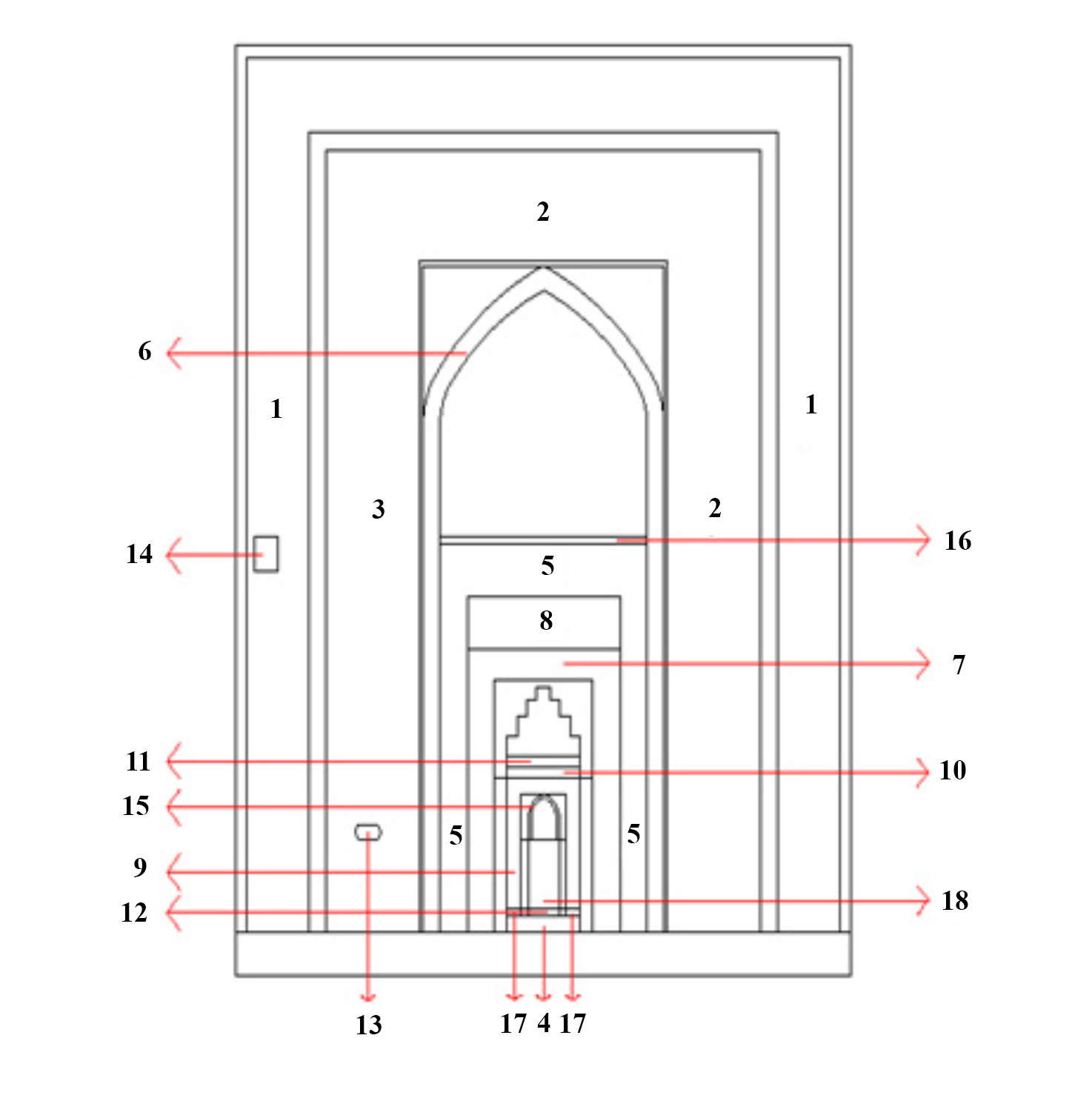
Video 1. Video of the ‘pish-e ru’ mihrab’s historical inscriptions, showing them in this order: the name of the patron ʿAbd al-Aziz b. Adam (no. 14 in fig. 4), the signature of Mohammad b. Abi Taher (no. 13), the date of Rabiʿ al-Thani 612/August 1215 (no. 4), and the signature of Abu Zayd (no. 11). Video by Sakineh Yousefi, in collaboration with the Evaluation, Documentation, and Research Department of the Astan-e Qods-e Razavi Museum, 2024.
The other inscriptions on the ‘pish-e ru’ mihrab include Qurʾanic verses executed in sols (thuluth), naskh, and Kufic scripts. The sols inscriptions, which are written on the borders and arches of the mihrab, include verses 114–115 and part of verse 116 from sura Hud (first border), verses 144–145 from sura al-Baqarah (second border), verse 285 from sura al-Baqarah (first arch), part of verse 153 from sura al-Baqarah (lower border of the second and third arches), verse 56 from sura al-Ahzab (between the first and second arches), verse 18 and part of verse 19 from sura AliʿImran (second border of the second arch), verse 1 from sura al-Fath (under the third arch), sura al-Towhid ([al-Ikhlas], on the third arch), and a hadith from Emam ʿAli (AS) in its border.
The second mihrab, located on the southeast, bears no signatures or dates but was likely created by the same potters, given its similarity in form and craftsmanship (figs. 5–6 and vid. 2). This mihrab is located toward the feet of Emam Reza’s zarih, which is why it is known as the mihrab beneath the foot (pa’in-e pa) of Hazrat-e Reza (محراب پایین پای حضرت رضا). Unlike the ‘pish-e ru’ mihrab, which only served a symbolic and ceremonial purpose, prayers were held in front of the ‘pa’in-e pa’ mihrab [see fig. 2 for the open space in front]). This mihrab is also covered in Qurʾanic verses: verses 55–57 from sura al-Maʾidah, verses 78–80 from sura al-Israʾ, verses 1–7 from sura al-Muʾminun, verse 18 and part of verse 19 from sura AliʿImran, and verses 268–285 from sura al-Baqarah. On the border of the larger arch, it is written: “Repaired in the year 1401/1980–81 by Shaykh Hosayn and others.”


Video 2. The ‘pa’in-e pa’ mihrab (B) in the Razavi Museum, Shrine of Emam Reza, Mashhad. Video by Sakineh Yousefi, in collaboration with the Evaluation, Documentation, and Research Department of the Astan-e Qods-e Razavi Museum, 2023.
Unfortunately, repeated restorations of both mihrabs have resulted in the disorder and replacement of some of their elements. For example, the columns within the mihrabs, which were initially made of luster tiles with scroll and vegetal patterns, were replaced with marble semi-columns (fig. 7). During renovations of the shrine in 1355–56 Sh/1976–78, the two mihrabs were removed from the tomb and transferred to the newly built central museum, which opened in 1356 Sh/1977–78 (map) (fig. 8). For further information, please see my 2013 article, which also discusses a third luster mihrab once in the adjacent portico/mosque [‘Bala-Sar Mosque’ in this plan].

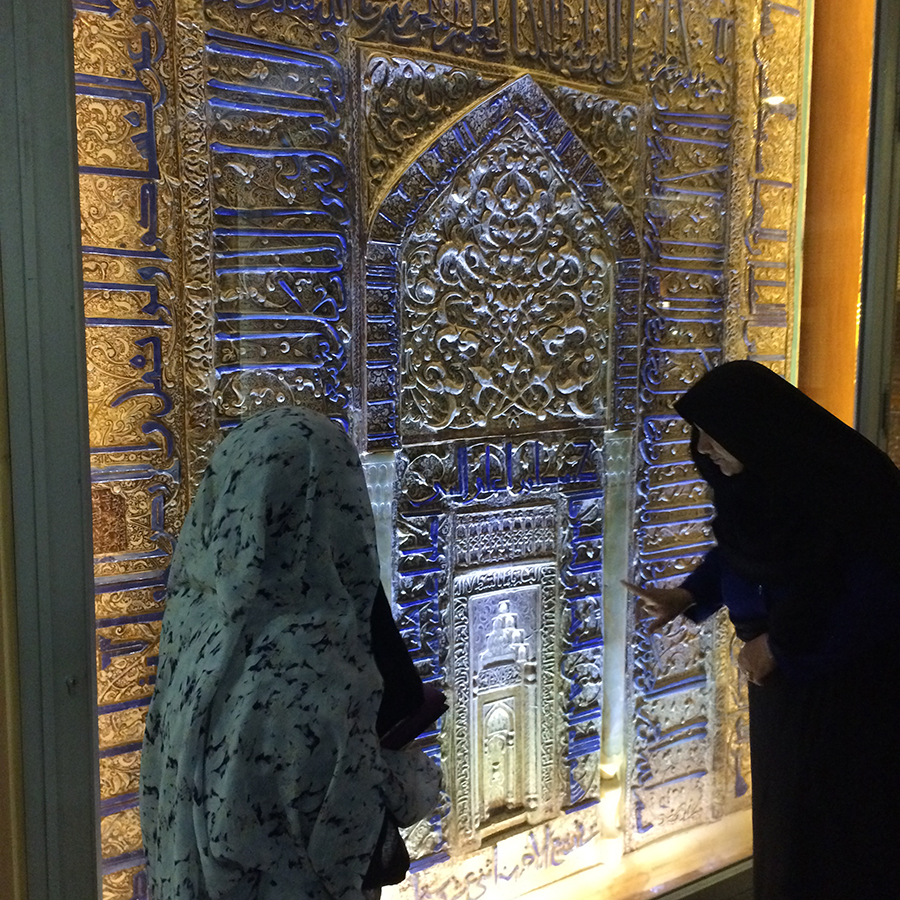
Due to the large number of visitors to the shrine, the central arches on each side of the tomb have been expanded. On the south side, a gilded door has been installed, and silver doors occupy the former positions of the mihrabs (fig. 9). The lower walls are still covered with luster tiles, some of which have been restored (fig. 10).
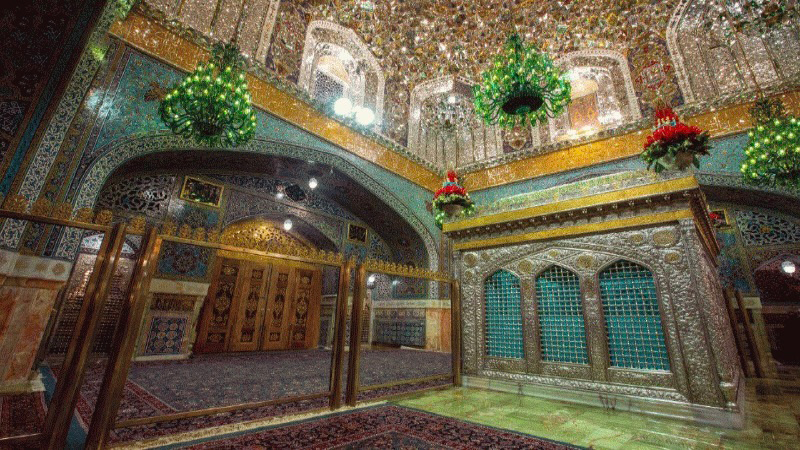
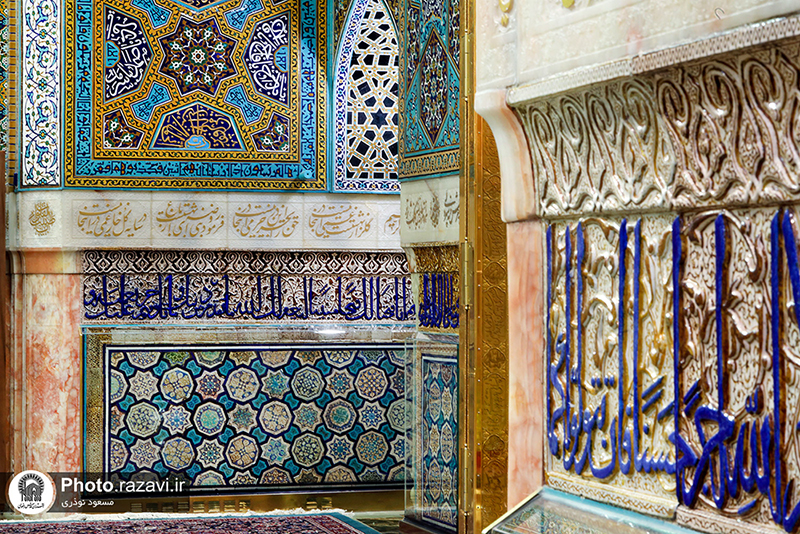
Sources:
- کفیلی، حشمت. «محرابهای زرینفام حرم مطهر در موزه مرکزی آستان قدس رضوی.» در: نشریهی الکترونیکی شمسه، شمارهی ۱۸ (بهار ۱۳۹۲ش.): ۱-۲۸. [Kafili, Luster mihrabs of the Holy Shrine in the Central Museum of Astan-e Qods-e Razavi, 2013] [Shamseh]
- کفیلی، حشمت. جام جهانبین: گزیدهای از نفایس موزه رضوی در فهرست آثار ملی ایران. تهران: پژوهشگاه میراث فرهنگی کشور با همکاری سازمان کتابخانهها، موزهها و مرکز اسناد آستان قدس رضوی، ۱۴۰۳ش. [Kafili, Jam-e Jahanbin: A selection of treasures from the Razavi Museum on the national list of Iranian heritage, 2024]
- کفیلی، حشمت، مریم حبیبی و محمدرضا شاهرودیزاده. موزههای آستان قدس رضوی. تهران: پژوهشگاه میراث فرهنگی کشور با همکاری سازمان کتابخانهها، موزهها و مرکز اسناد آستان قدس رضوی، ۱۳۹۶ش. [Kafili et al., Museum of Astan-e Qods-e Razavi, 2017]
Citation: Heshmat Kafili, “Two mihrabs of the tomb of Emam Reza in the Shrine of Emam Reza (AS) at Mashhad,” translated by Hoda Nedaeifar. Catalog entry in The Emamzadeh Yahya at Varamin: An Online Exhibition of an Iranian Shrine, directed and edited by Keelan Overton. 33 Arches Productions, January 15, 2025. Host: Khamseen: Islamic Art History Online.
